![]()
Kevrave
Productions
|
Visit the Rootin' Around Bookstore! Find and order books and CDs about rootin' tootin' music, roadtrips, history and other wacky stuff... |
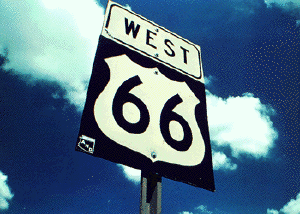
- "Used to Be," The Red Dirt Rangers
The throbbing hum of the interstate, the occasional bark of a stray dog and the piercing whistle of the high desert wind is the only music playing tonight along the crumbling, nearly abandoned main streets of Glenrio, Texas, and Two Guns, Arizona. An eerie silence is all that emanates from these once-bustling tourist stopovers along old US 66, affectionately known in its mid-century heyday as The Main Street of America.
From the late '20s through the early '60s, Route 66 was a pulsing artery of commerce and culture, both of which flowed freely and easily over the old road's 2,200-mile course, from its grand beginning at the foot of Chicago's stately Art Institute to the neon glow of the Santa Monica Pier at the other end of the rainbow. Gas stations, diners, motor courts, tourist traps and dancehalls sprang up all along the road soon after its inauguration in 1926, bringing the world to the doorsteps of fuel stops like Glenrio and Two Guns and jump-starting the nightlife of old cowboy and railroad towns like northeastern Arizona's Winslow (pop. 8,190).
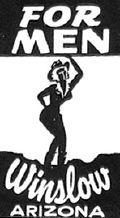
"Winslow just rocked when I was a little girl," recalls Diane Patterson, 50, who now runs a Route 66 memorabalia and souvenir mail-order business called Roadworks out of her old frame house on W. 3rd St. -- one of the identities old 66 assumes as it passes through Winslow's still-intact, but half-empty business district. "They used to call this place Little Las Vegas because it never closed. You could always hear music drifting up the road at night. Everyone played here -- Bob Wills, Roy Orbison, Johnny Cash. It was wild!"
Route 66 lost its official federal highway designation in October 1984, when the last stretch of Interstate 40 bypassed Williams, Arizona -- an event which, ironically, seemed to galvanize many of the old 66 towns into action.
Over the past decade, a dogged corps of small town residents, businessmen and pop culture fanatics have banded together in an attempt to lure tourism and entertainment back to once-thriving Route 66 business districts. Steinbeck's "Mother Road" has spawned at least three international magazines, three museums, eight state associations and four other organizations in the Netherlands, Brussels, Japan and France, in addition to countless books, videos, CD-ROMs, calendars, coffee cups, t-shirts and designer watches.
And last November, the highway celebrated in songwriter Bobby Troup's classic "(Get Your Kicks on) Route 66" finally achieved official '90s hipster status with the release of the first US 66 tribute CD, The Songs of Route 66 -- Music From the All-American Highway (Lazy SOB Recordings).
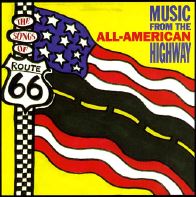
The CD was produced by Asleep at the Wheel's David Sanger. The Austin-based drummer first stumbled upon the old road during the hard-traveling western-swing band's 1992 Route 66 tour, sponsored by Coors.
"With the band, I traveled on interstates all the time," says Sanger, who grew up in Claremont, California, at the point where old 66 turns into Foothill Blvd. on its way into Los Angeles. "This was a completely different way to travel. You were just on a road, but you felt so much better when you were on it. Trying to follow the old alignment -- taking a left here, being careful not to miss a sign here -- sometimes I'd find myself pulling over and asking people sitting in their front yards, 'Where's Route 66?'"
The old road pops up in several different incarnations throughout The Songs of Route 66. Kicking off with a space-age send-up of Nelson Riddle's theme from the '60s "Route 66" TV series, the compilation takes the listener on a varied tour of the different images conjured up by this near-mythic highway. Bobby Troup lays down a scatted lead vocal over a rippling jazz piano on a rare live recording of "Route 66," which also gets the after-hours L.A. blues treatment from smooth, velvet-voiced r&b veteran Charles Brown.
Oklahoma City's Red Dirt Rangers set the bittersweet tone for the collection on their swirling "Used to Be," while alternative country singer/songwriters Kevin Welch ("The Willy Rogers Highway"), Alan Rhody ("The Mother Road"), Mary Cutrufello ("The Long Red Line") and Jimmy LaFave ("Route 66 Revisited") chime in with their own engaging takes on the themes of loss and wanderlust.
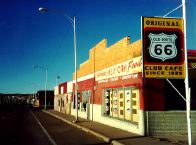
Sanger got the idea for the compilation in 1992, when he first heard Alan Rhody and Kevin Welch's "The Mother Road." "I was amazed to learn that this was only the second popular song ever recorded about Route 66," says Sanger. "So I decided to try and get a bunch of songs together and start my own label to put out a CD with songs about the old road."
Sanger's efforts to license Asleep at the Wheel and Nat King Cole's swinging versions of "Route 66" from Capitol Records came up short. Luckily, there were many more from which to choose.
Route 66 Magazine publisher Paul Taylor estimates that over 75 different artists have waxed versions of Bobby Troup's infectious highway ode. The list reads like a who's who of modern rock, schlock and soul: The Cramps, Anita Bryant, Louis Jordan, The Rolling Stones, Sammy Davis Jr., The Replacements, Chuck Wagon & the Wheels and -- most recently -- Depeche Mode.
"All the big bands, country acts and rock groups traveled along Route 66," says Taylor, a retired ad/PR executive who started the 64-page bimonthly magazine in 1993 out of his retirement home in Laughlin, Nevada. "So it was just natural that they'd record a version of a song about the road they spent so much time on."
Taylor's personal favorite, a barbershop quartet rendition by The Most Happy Fellows, didn't make the CD, losing out to the laid-back blues version cut by Charles Brown on his comeback Alligator album, One More for the Road, and the long out-of-print live Troup cut. "I found that one on an old album I picked up at a tiny store in downtown Kingman," recalls Sanger. "It's the only place I've ever run across it."
The Songs of Route 66 began shipping in November 1995, and has already sold out of its small initial pressing of 1,000 CDs and 1,000 cassettes. Most sales have come through mail-order or Route 66 souvenir shops along the old road from Chicago to L.A.
Flagstaff's Museum Club's gift shop serves up The Songs of Route 66 CD alongside a well-preserved slice of old Route 66 country roadhouse life. This 66-year-old Southwestern dancehall institution is known around town as The Zoo due to both its otherworldly origins as a mysterious taxidermy museum and the rough-and-rowdy honky tonk crowds who used to flock there during the club's '50s and '60s glory days.
"Flagstaff was only five hours away from Las Vegas, where the biggest gig in country music back then was a run at the Golden Nugget club," says Martin Zanzucchi, who bought the Museum Club in 1978 and painstakingly restored the rambling roadhouse to its original eclectic condition, stuffed bobcats, bears, owls, peacocks and all. "Acts like Buck Owens, Willie Nelson, Waylon Jennings and Bob Wills & the Texas Playboys would stop at the Zoo to pick up enough cash to get them the rest of the way to Vegas."
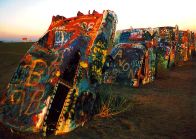
The bottle-throwing, longhair-hating honky tonk fans who gave the place its tough reputation in the '60s have been seamlessly replaced with a more sanitized, crisply attired Western crowd, which glides effortlessly around the bandstand and rock-studded old fireplace to the sounds of local country, rock and reggae bands and the occasional bigger-name national act like Sanger's Asleep at the Wheel or blues performer Robert Cray.
Tucson's cult country-rock legends, The Dusty Chaps, were frequent performers at The Museum Club along with the like-minded Commander Cody & His Lost Planet Airmen ("Hot Rod Lincoln") back in the genre-bending mid-'70s. Original Dusty Chaps singer Peter Gierlich and guitarist George Hawke reprise that wider-open musical era for Sanger's The Songs of Route 66 project with a new studio recording of "Don't Haul Bricks on 66." This freewheeling tale of the dangers of smuggling pot across the northern Arizona desert appeared in its original form on the group's first mid-'70s Capitol album.
"The title was based on some graffiti that someone we knew had seen on a jail cell in Albuquerque," recalls Hawke, who now splits his time between Tucson and L.A. as a studio musician and member of Tucson's Los Lasers. "The rest of the song was a mixed bag of references to these characters we met playing clubs along the road -- a strange bunch of 18-year-old millionaires flashing $100 bills and goofy nicknames like Pineapple and Toad."
The names have changed but the characters are as vivid as ever in the old 66 towns across northern Arizona, where the nation's longest continuous stretch of original roadway makes a stunning, 160-mile run from sleepy Seligman on over the jagged Black Mountains to Topock, near the sunbaked California border town of Needles. Rough, wide-open sections of road like these conjure up a sense of the dangers and difficulties that confronted the many migrants -- profiled in Steinbeck's The Grapes of Wrath -- who crossed the unforgiving desert on Route 66 en route to the not-so-Golden State.
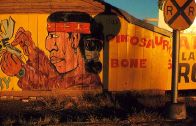
The Depression-era Okie migration is a central theme of Woody Guthrie's "Willy Rogers Highway," served up in a beautiful, loping form by songwriter Kevin Welch on The Songs of Route 66. Welch spent the first seven years of his life zooming back and forth across the country, often along US 66, as his family followed his father's many jobs as a military contractor in the late '50s and early '60s. The family eventually settled in Midwest City, Oklahoma, within striking distance of Oklahoma City and US 66.
"I remember my dad telling me about the old road whenever we would cross it," remembers Welch, 41, who now lives in Nashville. The singer/songwriter splits his time touring behind his acclaimed 1995 Life Down Here on Earth (Dead Reckoning) album and helping songwriter Kieran Kane run the renegade Dead Reckoning label Welch and Kane co-founded last year. "My dad would tell me, 'If you take a right turn here, you go straight to Chicago. And a left takes you all the way to California.' After growing up on the move for so long and then having to come to a complete stop in a town like Midwest City, it was comforting to have such a road so close by."
Welch got back in touch with the spirit of 66 in the early '90s, when he and Nashville friend Alan Rhody penned "The Mother Road." The song appeared on Welch's first Warner Brothers album, Kevin Welch, and led to an unplugged stint opening for author Michael Wallis on his Chicago-L.A. Route 66 bookstore tour in 1991 to promote the release of the Tulsa writer's Route 66 -- The Mother Road -- revered by many US 66 fanatics as the veritable Bible of the old road.
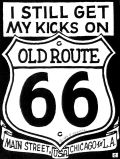
Rambling musician, poet and sketchbook artist Jason Eklund paints a more sobering, weatherbeaten portrait of the death of old US 66 and the nostalgia-fueled drive to cash in on the road's re-emerging popularity in his acerbic, hard-rocking rant, "What's Left of 66," originally released on his 1995 album, Lost Causeway (Flying Fish). This manic jugband stomper levels a searing blast at the blighted miles of "corporate crapola" which have emerged in the wake of the progress-preaching interstate movement.
"You're not going to make any really new discoveries traveling Route 66 -- it's all been so conveniently packaged and catalogued for you," says Eklund, a road-tested wanderer who has spent the last seven years "hobo-cruising and checking out all the different scenes, hanging out and hiding out, picking up whatever work I can find to keep my car running and my stomach full.
"They tore all the really cool stuff down, like the Coral Court Motel [a classic glass-block, 1941 art deco St. Louis motor court that was demolished in 1995], and turned everything else into some ridiculous commodity."
A conversation with Winslow's Diane Patterson and her energetic younger sister, Janice Griffith, however, offers hope that there at least a few unheralded wonders still waiting to be unveiled along the old road.
"Route 66 gave towns like ours something to replace the traffic that stopped when the trains stopped coming as often in the '50s," says the tireless Griffith, who serves as director of the eclectic Old Trails Museum housed in downtown Winslow in a restored early 1916 bank building. "No one took this road for granted. But when the interstate opened, the world stopped coming to our door. It almost killed our town."
Most recently immortalized in song in the Eagles' "Take It Easy," Winslow was a bustling Santa Fe railroad town and tourist destination long before any girls drove flatbed Fords or Glenn Frey stood on any corners.
"That song really put us back on the map," says Patterson. "When I first heard it in a concert back in my hippie days in Colorado, we all just stood up and flicked our Bics and yelled like crazy."
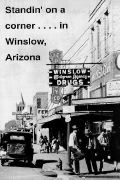
She and Janice have been instrumental in the design of the soon-to-be-constructed "Standin' on the Corner" Park (at the intersection of Kinsley Ave. and 2nd St.), made possible by a $2,500 grant the city received from Eagles singer Don Henley in response to a letter and set of "Standin' on a Corner in Winslow, Arizona" t-shirts Griffith and Patterson had delivered to the band during The Eagles' 1994 America West Arena concert.
In addition to lobbying for the park's construction and maintaining the fascinating collection of local historical artifacts and Route 66 memorabalia that comfortably clutters her carefully laid-out Old Trails museum, Griffith has waged a seven-year crusade to further the restoration of Winslow's La Posada, a stately Spanish-style resort hotel built in 1927 as the last of the once-ubiquitous Harvey Houses by famed architect Mary Colter.
Griffith's efforts to bring La Posada back to the grandeur it enjoyed when it housed guests like Charles Lindbergh, John Wayne, Erroll Flynn and Will Rogers appear to be on the verge of succeeding. A southern California investor has expressed interest in purchasing the elegant old hotel to restore it to its former splendor.
"I heard a rumor that they're even thinking about bringing back the old bandstand in front of the hotel," sighs Patterson, with the breathless anticipation of one who is keeping her fingers crossed. "Wouldn't it be great if we could have music again?"
Contact Information: The Songs of Route 66 -- Music From the All-American Highway, Lazy SOB Recordings, P.O. Box 49884, Austin, TX 78764-9884, 512/480-0765
- By Kevin Roe
|
|
|
|
|
|
|
|
|
|
|
|
|
|
|
-
© 2001, Kevrave Productions